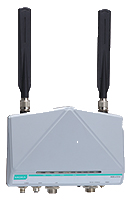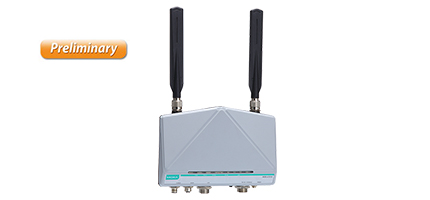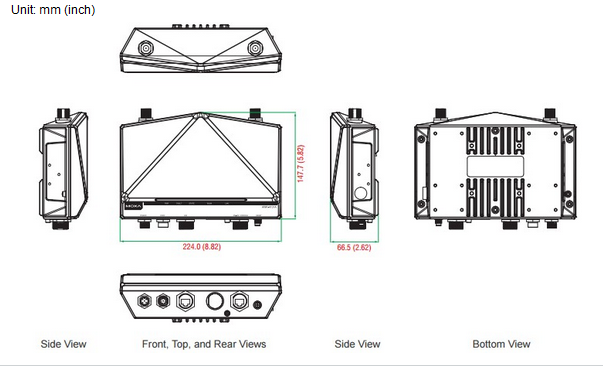MOXA AWK-4131A
Outdoor industrial IEEE 802.11a/b/g/n wireless AP/bridge/client




- IEEE 802.11a/b/g/n AP/bridge/client support
- Seamless roaming with Turbo Roaming
- Complete redundancy with AeroLink Protection
- Integrated antenna and power isolation
- Rugged IP68-rated housing and -40 to 75°C operating temperature
- 5 GHz DFS channel support
Der AWK-4131A, ein in der Schutzart IP68 aufgebauter industrieller AP/Bridge/Client für den Außenbereich, ist die Antwort auf den wachsenden Bedarf an Komponenten mit höheren Datenraten.
Er unterstützt die 802.11n-Technologie und erreicht nach dem 2x2-MIMO-Verfahren Nettodatenraten von bis zu 300 Mbps. Der AWK-4131A erfüllt Industriestandards und Zulassungsbedingungen hinsichtlich Betriebstemperatur, Versorgungsspannung, Überspannung, elektrostatischer Entladung und Vibrationen. Die zwei redundanten DC-Versorgungsspannungseingänge erhöhen die Zuverlässigkeit der Stromversorgung; der AWK-4131A kann aber auch über PoE betrieben werden, was die Installation vereinfacht. Der AWK-4131 kann wahlweise im 2,4- oder 5-GHz-Frequenzbereich betrieben werden und ist abwärtskompatibel mit bestehenden 802.11a/b/g-Systemen. Damit ist die Zukunftssicherheit Ihrer Investitionen in Wireless-Ressourcen gesichert.


Advanced 802.11n Industrial Wireless Solution
Advanced Wireless Technology
Industrial Ruggedness
WLAN Interface
Standards
IEEE 802.11a/b/g/n for Wireless LAN
IEEE 802.11i for Wireless Security
IEEE 802.3 for 10BaseT
IEEE 802.3u for 100BaseT(X)
IEEE 802.3ab for 1000BaseT
IEEE 802.3af for Power-over-Ethernet
IEEE 802.1D for Spanning Tree Protocol
IEEE 802.1w for Rapid STP
IEEE 802.1Q for VLAN
Spread Spectrum and Modulation (typical)
DSSS with DBPSK, DQPSK, CCK
OFDM with BPSK, QPSK, 16QAM, 64QAM
802.11b: CCK @ 11/5.5 Mbps, DQPSK @ 2 Mbps, DBPSK @ 1 Mbps
802.11a/g: 64QAM @ 54/48 Mbps, 16QAM @ 36/24 Mbps, QPSK @ 18/12 Mbps, BPSK @ 9/6 Mbps
802.11n: 64QAM @ 300 Mbps to BPSK @ 6.5 Mbps (multiple rates supported)
Operating Channels (central frequency)
2.412 to 2.472 GHz (13 channels)
5.180 to 5.240 GHz (4 channels)*
5.260 to 5.320 GHz (4 channels)
5.500 to 5.700 GHz (11 channels)*
*DFS (Dynamic Frequency Selection) channel support
In AP mode, when a radar signal is detected, the device will automatically switch to another channel. However according to regulations, after switching channels, a 60-second availability check period is required before starting the service.
Security
SSID broadcast enable/disable
Firewall for MAC/IP/Protocol/Port-based filtering
64-bit and 128-bit WEP encryption, WPA /WPA2-Personal and Enterprise (IEEE 802.1X/RADIUS, TKIP and AES)
Transmission Rates
802.11b: 1, 2, 5.5, 11 Mbps
802.11a/g: 6, 9, 12, 18, 24, 36, 48, 54 Mbps
802.11n: 6.5 to 300 Mbps (multiple rates supported)
TX Transmit Power
802.11b:
Typ. 26±1.5 dBm @ 1 Mbps, Typ. 26±1.5 dBm @ 2 Mbps
Typ. 26±1.5 dBm @ 5.5 Mbps, Typ. 25±1.5 dBm @ 11 Mbps
802.11g:
Typ. 23±1.5 dBm @ 6 to 24 Mbps, Typ. 22±1.5 dBm @ 36 Mbps
Typ. 20±1.5 dBm @ 48 Mbps, Typ. 19±1.5 dBm @ 54 Mbps
802.11n (2.4 GHz):
Typ. 23±1.5 dBm @ MCS0/8 20 MHz, Typ. 18±1.5 dBm @ MCS7/15 20 MHz
Typ. 23±1.5 dBm @ MCS0/8 40 MHz, Typ. 17±1.5 dBm @ MCS7/15 40 MHz
802.11a:
Typ. 23±1.5 dBm @ 6 to 24 Mbps, Typ. 21±1.5 dBm @ 36 Mbps
Typ. 20±1.5 dBm @ 48 Mbps,Typ. 18±1.5 dBm @ 54 Mbps
802.11n (5 GHz):
Typ. 23±1.5 dBm @ MCS0/8 20 MHz, Typ. 18±1.5 dBm @ MCS7/15 20 MHz
Typ. 23±1.5 dBm @ MCS0/8 40 MHz, Typ. 18±1.5 dBm @ MCS7/15 40 MHz
Note
Based on regional regulations, the maximum transmission power allowed on the UNII bands is restricted in the firmware, as per the following list: Table
RX Receive Sensitivity
802.11b:
-93 dBm @ 1 Mbps, -93 dBm @ 2 Mbps
-93 dBm @ 5.5 Mbps, -88 dBm @ 11 Mbps
802.11g:
-88 dBm @ 6 Mbps, -86 dBm @ 9 Mbps
-85 dBm @ 12 Mbps, -85 dBm @ 18 Mbps
-85 dBm @ 24 Mbps, -82 dBm @ 36 Mbps
-78 dBm @ 48 Mbps, -74 dBm @ 54 Mbps
802.11n (2.4 GHz):
-70 dBm @ MCS7 20 MHz, -69 dBm @ MCS15 20 MHz
-67 dBm @ MCS7 40 MHz, -67 dBm @ MCS15 40 MHz
802.11a:
-90 dBm @ 6 Mbps, -88 dBm @ 9 Mbps
-88 dBm @ 12 Mbps, -85 dBm @ 18 Mbps
-81 dBm @ 24 Mbps, -78 dBm @ 36 Mbps
-74 dBm @ 48 Mbps, -72 dBm @ 54 Mbps
802.11n (5 GHz):
-69 dBm @ MCS7 20 MHz, -71 dBm @ MCS15 20 MHz
-63 dBm @ MCS7 40 MHz, -68 dBm @ MCS15 40 MHz
Protocol Support
General Protocols
Proxy ARP, DNS, HTTP, HTTPS, IP, ICMP, SNTP, TCP, UDP, RADIUS, SNMP, DHCP, VLAN, STP/RSTP
Interface
Default Antennas
2 dual-band omni-directional antennas, 5 dBi at 2.4 GHz, 2 dBi at 5 GHz, N-type (male)
Connector for External Antennas
N-Type (female), 500 V insulation
LAN Ports
1, RJ45, 10/100/1000BaseT(X) auto negotiation speed, F/H duplex mode, and auto MDI/MDI-X connection
Console Port
RS-232 (waterproof RJ45-type)
Reset
Present
LED Indicators
PWR, FAULT, STATE, WLAN, LAN
Alarm Contact (digital output)
M12 connector, 1 relay output with current carrying capacity of 1 A @ 24 VDC
Digital Inputs
M12 connector, 2 electrically isolated inputs +13 to +30 V for state “1”
+3 to -30 V for state “0”
Max. input current: 8 mA
Management
Device Management
Wireless Search Utility, MXconfig, SNMP
Network Monitoring MXview
Physical Characteristics
Housing
Metal, IP68 protection
Weight
1400 g (3.09 lb)
Dimensions
224 x 148 x 67 mm (8.82 x 5.82 x 2.62 in)
Installation
Wall mounting (standard), DIN-rail mounting (optional), pole mounting (optional)
Environmental Limits
Operating Temperature
-40 to 75°C (-40 to 167°F)
Storage Temperature
-40 to 85°C (-40 to 185°F)
Ambient Relative Humidity
5% to 95% (non-condensing)
Power Requirements
Input Voltage
12 to 48 VDC, redundant dual DC power inputs or 48 VDC Power-over-Ethernet (IEEE 802.3af compliant)
Input Current
0.64 A @ 12 VDC; 0.16 A @ 48 VDC
Connector
M12 A-coding connector (male), 500 V insulation
Power Consumption
7.68 W
Reverse Polarity Protection
Present
Standards and Certifications
Safety
UL 60950-1, EN 60950-1
EMC
EN 61000-6-2/6-4
EMI
CISPR 22, FCC Part 15B Class B
EMS
IEC 61000-4-2 ESD: Contact 8 kV; Air 15 kV
IEC 61000-4-3 RS: 80 MHz to 1 GHz: 10 V/m
IEC 61000-4-4 EFT: Power 2 kV; Signal 1 kV
IEC 61000-4-5 Surge: Power 2 kV; Signal 1 kV
IEC 61000-4-6 CS: 10 V
IEC 61000-4-8
Radio
EN 301 489-1/17, EN 300 328, EN 301 893, TELEC, FCC ID SLE-WAPN008
MTBF (mean time between failures)
Time
440,764 hrs
Standard
Telcordia SR332
Ordering Information
AWK-4131A-EU-T
- 802.11a/b/g/n compliant AP/bridge/client for flexible deployment
- Software optimized for long distance (LoS, 1 km) wireless communication with external high-gain antenna (available on 5 GHz)
- Maximum of 100 clients, tested with 60 concurrent clients (AP mode)
- DFS channel support allows a wider range of 5 GHz channel selection to avoid existing wireless infrastructure and interference
Advanced Wireless Technology
- Seamless roaming with Client-based Turbo Roaming for < 150 ms roaming recovery time between APs (Client mode)
- Supports AeroLink Protection for creating a redundant wireless link (< 300 ms recovery time) between AP and clients (Client mode)
Industrial Ruggedness
- Integrated antenna and power isolation designed to provide 500 V insulation protection against external electrical interference
- IP68 rated metal casing for complete ingress protection for any outdoor weather
- -40 to 75°C wide operating temperature provided for smooth wireless communication in harsh environments
WLAN Interface
Standards
IEEE 802.11a/b/g/n for Wireless LAN
IEEE 802.11i for Wireless Security
IEEE 802.3 for 10BaseT
IEEE 802.3u for 100BaseT(X)
IEEE 802.3ab for 1000BaseT
IEEE 802.3af for Power-over-Ethernet
IEEE 802.1D for Spanning Tree Protocol
IEEE 802.1w for Rapid STP
IEEE 802.1Q for VLAN
Spread Spectrum and Modulation (typical)
DSSS with DBPSK, DQPSK, CCK
OFDM with BPSK, QPSK, 16QAM, 64QAM
802.11b: CCK @ 11/5.5 Mbps, DQPSK @ 2 Mbps, DBPSK @ 1 Mbps
802.11a/g: 64QAM @ 54/48 Mbps, 16QAM @ 36/24 Mbps, QPSK @ 18/12 Mbps, BPSK @ 9/6 Mbps
802.11n: 64QAM @ 300 Mbps to BPSK @ 6.5 Mbps (multiple rates supported)
Operating Channels (central frequency)
2.412 to 2.472 GHz (13 channels)
5.180 to 5.240 GHz (4 channels)*
5.260 to 5.320 GHz (4 channels)
5.500 to 5.700 GHz (11 channels)*
*DFS (Dynamic Frequency Selection) channel support
In AP mode, when a radar signal is detected, the device will automatically switch to another channel. However according to regulations, after switching channels, a 60-second availability check period is required before starting the service.
Security
SSID broadcast enable/disable
Firewall for MAC/IP/Protocol/Port-based filtering
64-bit and 128-bit WEP encryption, WPA /WPA2-Personal and Enterprise (IEEE 802.1X/RADIUS, TKIP and AES)
Transmission Rates
802.11b: 1, 2, 5.5, 11 Mbps
802.11a/g: 6, 9, 12, 18, 24, 36, 48, 54 Mbps
802.11n: 6.5 to 300 Mbps (multiple rates supported)
TX Transmit Power
802.11b:
Typ. 26±1.5 dBm @ 1 Mbps, Typ. 26±1.5 dBm @ 2 Mbps
Typ. 26±1.5 dBm @ 5.5 Mbps, Typ. 25±1.5 dBm @ 11 Mbps
802.11g:
Typ. 23±1.5 dBm @ 6 to 24 Mbps, Typ. 22±1.5 dBm @ 36 Mbps
Typ. 20±1.5 dBm @ 48 Mbps, Typ. 19±1.5 dBm @ 54 Mbps
802.11n (2.4 GHz):
Typ. 23±1.5 dBm @ MCS0/8 20 MHz, Typ. 18±1.5 dBm @ MCS7/15 20 MHz
Typ. 23±1.5 dBm @ MCS0/8 40 MHz, Typ. 17±1.5 dBm @ MCS7/15 40 MHz
802.11a:
Typ. 23±1.5 dBm @ 6 to 24 Mbps, Typ. 21±1.5 dBm @ 36 Mbps
Typ. 20±1.5 dBm @ 48 Mbps,Typ. 18±1.5 dBm @ 54 Mbps
802.11n (5 GHz):
Typ. 23±1.5 dBm @ MCS0/8 20 MHz, Typ. 18±1.5 dBm @ MCS7/15 20 MHz
Typ. 23±1.5 dBm @ MCS0/8 40 MHz, Typ. 18±1.5 dBm @ MCS7/15 40 MHz
Note
Based on regional regulations, the maximum transmission power allowed on the UNII bands is restricted in the firmware, as per the following list: Table
RX Receive Sensitivity
802.11b:
-93 dBm @ 1 Mbps, -93 dBm @ 2 Mbps
-93 dBm @ 5.5 Mbps, -88 dBm @ 11 Mbps
802.11g:
-88 dBm @ 6 Mbps, -86 dBm @ 9 Mbps
-85 dBm @ 12 Mbps, -85 dBm @ 18 Mbps
-85 dBm @ 24 Mbps, -82 dBm @ 36 Mbps
-78 dBm @ 48 Mbps, -74 dBm @ 54 Mbps
802.11n (2.4 GHz):
-70 dBm @ MCS7 20 MHz, -69 dBm @ MCS15 20 MHz
-67 dBm @ MCS7 40 MHz, -67 dBm @ MCS15 40 MHz
802.11a:
-90 dBm @ 6 Mbps, -88 dBm @ 9 Mbps
-88 dBm @ 12 Mbps, -85 dBm @ 18 Mbps
-81 dBm @ 24 Mbps, -78 dBm @ 36 Mbps
-74 dBm @ 48 Mbps, -72 dBm @ 54 Mbps
802.11n (5 GHz):
-69 dBm @ MCS7 20 MHz, -71 dBm @ MCS15 20 MHz
-63 dBm @ MCS7 40 MHz, -68 dBm @ MCS15 40 MHz
Protocol Support
General Protocols
Proxy ARP, DNS, HTTP, HTTPS, IP, ICMP, SNTP, TCP, UDP, RADIUS, SNMP, DHCP, VLAN, STP/RSTP
Interface
Default Antennas
2 dual-band omni-directional antennas, 5 dBi at 2.4 GHz, 2 dBi at 5 GHz, N-type (male)
Connector for External Antennas
N-Type (female), 500 V insulation
LAN Ports
1, RJ45, 10/100/1000BaseT(X) auto negotiation speed, F/H duplex mode, and auto MDI/MDI-X connection
Console Port
RS-232 (waterproof RJ45-type)
Reset
Present
LED Indicators
PWR, FAULT, STATE, WLAN, LAN
Alarm Contact (digital output)
M12 connector, 1 relay output with current carrying capacity of 1 A @ 24 VDC
Digital Inputs
M12 connector, 2 electrically isolated inputs +13 to +30 V for state “1”
+3 to -30 V for state “0”
Max. input current: 8 mA
Management
Device Management
Wireless Search Utility, MXconfig, SNMP
Network Monitoring MXview
Physical Characteristics
Housing
Metal, IP68 protection
Weight
1400 g (3.09 lb)
Dimensions
224 x 148 x 67 mm (8.82 x 5.82 x 2.62 in)
Installation
Wall mounting (standard), DIN-rail mounting (optional), pole mounting (optional)
Environmental Limits
Operating Temperature
-40 to 75°C (-40 to 167°F)
Storage Temperature
-40 to 85°C (-40 to 185°F)
Ambient Relative Humidity
5% to 95% (non-condensing)
Power Requirements
Input Voltage
12 to 48 VDC, redundant dual DC power inputs or 48 VDC Power-over-Ethernet (IEEE 802.3af compliant)
Input Current
0.64 A @ 12 VDC; 0.16 A @ 48 VDC
Connector
M12 A-coding connector (male), 500 V insulation
Power Consumption
7.68 W
Reverse Polarity Protection
Present
Standards and Certifications
Safety
UL 60950-1, EN 60950-1
EMC
EN 61000-6-2/6-4
EMI
CISPR 22, FCC Part 15B Class B
EMS
IEC 61000-4-2 ESD: Contact 8 kV; Air 15 kV
IEC 61000-4-3 RS: 80 MHz to 1 GHz: 10 V/m
IEC 61000-4-4 EFT: Power 2 kV; Signal 1 kV
IEC 61000-4-5 Surge: Power 2 kV; Signal 1 kV
IEC 61000-4-6 CS: 10 V
IEC 61000-4-8
Radio
EN 301 489-1/17, EN 300 328, EN 301 893, TELEC, FCC ID SLE-WAPN008
MTBF (mean time between failures)
Time
440,764 hrs
Standard
Telcordia SR332
Ordering Information
AWK-4131A-EU-T
- IEEE 802.11a/b/g/n IP68 wireless AP/bridge/client, EU band, -40 to 75°C operating temperature
 Kunden, die diesen Artikel gesehen haben, sahen auch
Kunden, die diesen Artikel gesehen haben, sahen auch












 Eigenschaften
Eigenschaften Beschreibung
Beschreibung Weitere Informationen
Weitere Informationen



 Eigenschaften
Eigenschaften Beschreibung
Beschreibung PDF
PDF